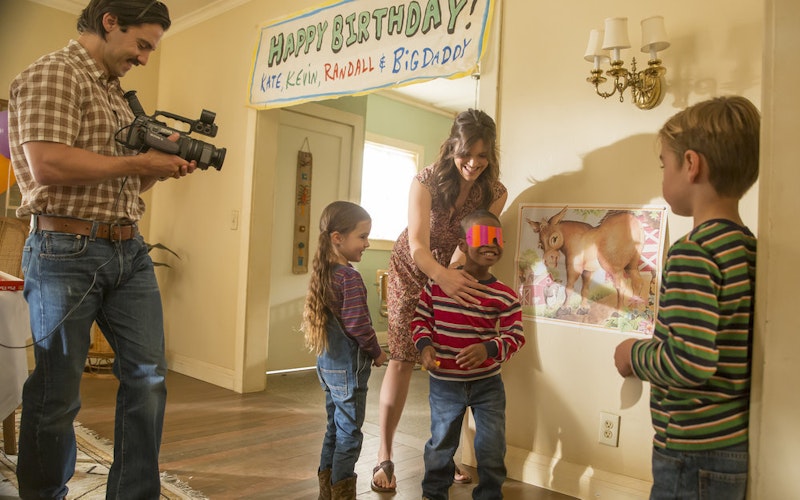
TV
This Is Us and Family Liturgy
This Is Us, which originally aired on NBC and is now streaming on Hulu, shows an amazing adoption story. After their third triplet is stillborn, new parents Jack (Milo Ventimiglia) and Rebecca (Mandy Moore) adopt an African-American baby. As the children grow, Jack and Rebecca attempt to teach them their identity as a family through a formative liturgy. Formally, the show utilizes a complex storytelling method that is liturgical in itself, alternating among the present day; the siblings’ childhood during the 1980s and 1990s; and Jack and Rebecca’s first days together in the early 1980s.
As parents of a racially mixed family, Jack and Rebecca knew their children would need a heightened sense of belonging. In the first episode, we witness a family practice that the show implies was repeated daily between Jack and his three children. Jack starts it off, with each child in order responding:
“First came…
“Me!” (oldest son Kevin)
“Then Dad said, ‘Wee!’”
“Then came…”
“Me!” (daughter Kate)
“And mom said, ‘Gee!’”
“Then came…”
“Me!” (adopted son Randall)
“And they said…
“‘That’s three!’”
“Big Three!” (all together)
In both the pilot and succeeding episodes, this ritual becomes a thread that even the adult siblings repeat to reestablish family unity. With adulthood, that unity is challenged. The siblings frequently get focused on other concerns: careers, personal issues, and relationships, all at the cost of their “Big Three” unity. Yet their parents’ training allows them to refocus on what brings them together, rather than what drives them apart. Such a liturgical way of living should familiar be to Christians; indeed, it’s almost biblical.
Exodus recounts the journey of God’s people as they leave behind centuries of slavery in Egypt. At this time, they were not yet prepared to be the covenant people. Moses led them to Mount Sinai, where two things happened: they received the law and they began to learn how to live under the covenant. Building the tabernacle, practicing right worship, learning to live in patterns which pleased this rescuing, redeeming God. All of this took time. And, as Exodus records, the Israelites often failed in their worship.
The necessity of learning worship and being formed through repetitive patterns is not just an Old Testament practice; Jesus did the same with his disciples. When the disciples asked, “Lord, teach us to pray,” he gave them a liturgical model. (“When you pray, say: ‘Father, hallowed be your name…”) At the beginning of his ministry, Jesus received baptism as a liturgical model. At the end of his three years, he gave his followers the practice of communion.
Such a liturgical way of living should be familiar to Christians.
In Desiring the Kingdom, James K.A. Smith argues that liturgies shape us. His book opens with an analysis of mall theology, noting the similarities between approaching a place of worship (arriving from a distance, bringing an offering, moving within the sacred space) and shopping at the mall (parking far away, bringing money, meandering through the stores). Smith contends that shopping can formatively shape us as materialistic beings. He then bridges from this mall theology to analyzing how liturgies form us as worshipping creatures. Borrowing from St. Augustine, Smith argues that loves flows from our hearts in certain directions; love is either aimed at God or elsewhere. Love is shaped by the habits (liturgies) in which we engage. Smith argues that while we may intellectually know we should love a certain practice (prayer, giving of time and resources, etc) it is often in the doing of that practice that we find out hearts shaped to feel the love that our minds understand to be proper.
God has made us to be worshipping, loving human beings whose love can go in a variety of directions. This Is Us illustrates the power that liturgical repetition has to draw us back to a central identity after wandering the wilds of the world. For centuries, Christians have studied catechisms, observed holy days, participated in the sacraments, and engaged in weekly hymn singing, scripture reading, and biblical preaching as essential liturgical practices. In so doing, we resonate with Old and New Testament saints learning how to love the God of salvation. Whether it is in the specific liturgical practices which remind the siblings of This Is Us of their identity or the larger liturgical pattern of the series’ alternating storylines, the show reminds us that liturgy—far from being boring repetition—is a key to spiritual health.
Topics: TV, Culture At Large, Arts & Leisure